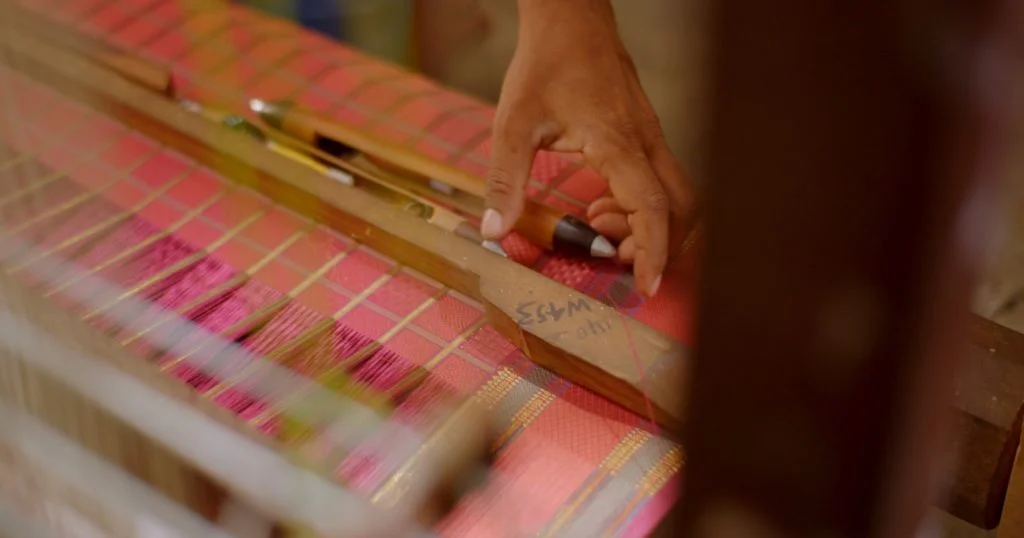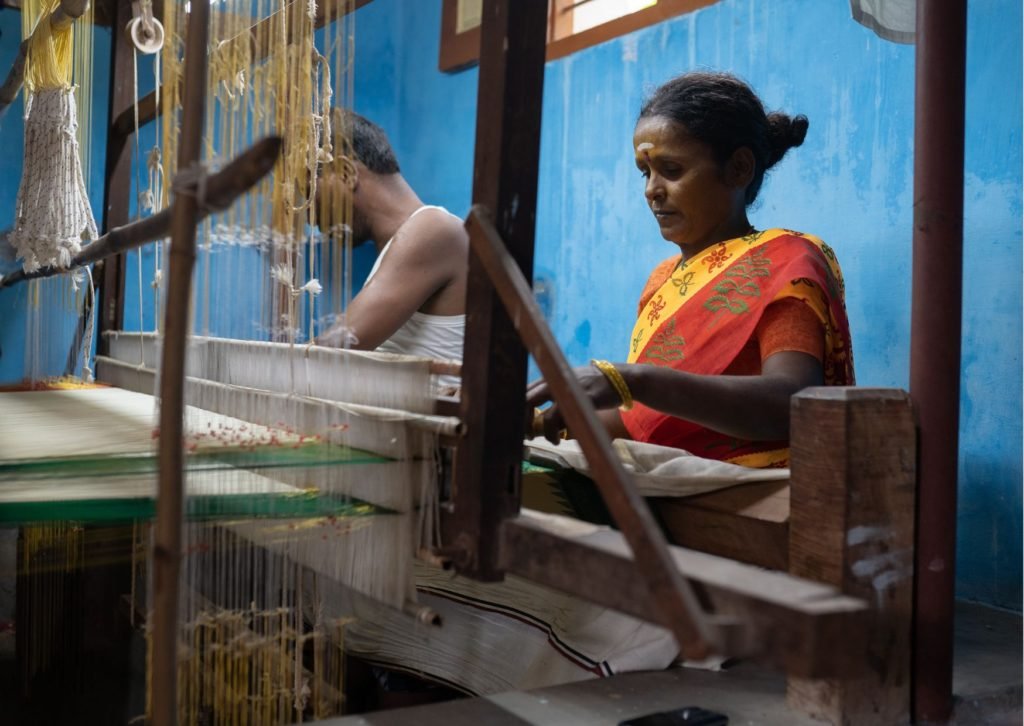Handloom, or handwoven, sarees are art that you can wear. Products of human skill and experience, handloom sarees are crafted by master weavers over days, sometimes even weeks. There are significant differences between handwoven sarees and those that have been manufactured on the power loom; here’s how you can spot them.
What is a handloom?
A loom is an equipment that’s used for weaving textiles. A handloom is manually operated by the weaver; a power loom, on the other hand, is automated and runs on electricity. The warp (the length of the fabric) is stretched across the handloom; the weaver sits at one end of the handloom and places the weft threads in ‘shuttles’, passing them through the width of the warp yarns to create the textile.
Handlooms are of three kinds – pit looms, stand looms and frame looms. In a broader sense, the Ministry of Textiles defines a handloom as one that requires human intervention. Many of the weavers in the RmKV facility in Tamil Nadu use pit looms to create our handwoven Kanchipuram silk sarees and award-winning innovations.

As the name implies, these handlooms are partially inserted into pits dug into the floor of the weaver’s house. The pedals of the handloom, called ‘treadles’, are placed inside the pit while the beam holding the warp yarns is just slightly higher than the floor. The weaver sits on
the floor of the house and pushes the treadles with his feet to operate the loom.
What makes a handloom saree special?
A handloom saree is crafted by a skilled artisan who intertwines the warp and weft threads on the loom. It takes decades for a weaver to acquire this expertise and dexterity, and most of this knowledge is passed on within the family, from one generation of weavers to the next.
India’s handloom industry was once the finest in the world. Cotton fabrics woven in Gujarat were found in ancient Egypt; till the 18th century, cottons from Bengal were essential to the economy, with Karl Marx noting that “The hand-loom and the spinning-wheel…were the pivots of the structure of that society”. Even today, the handloom industry is the second-largest employer in India’s rural areas, after agriculture.
Why is a handwoven saree considered inimitable? Quite simply, it’s the accumulation of human experience. A handcrafted product is the result of everything a weaver has learnt; the colours and patterns are a reflection of his taste; the slight changes in the weave show where he paused, and the barely-perceptible knots show where he deftly fixed broken threads. Each handloom saree is unique, because the weaver always alters the colours or patterns, even in sarees that have the same design.
In fact, a handcrafted saree isn’t the work of the weaver alone. Nearly 50 artisans contribute to the creation of a single handcrafted RmKV Kanchipuram silk saree, which often takes weeks to create. Here’s a look at the hands at work behind the handloom.
How do you identify a handloom saree?
Sometimes, even sarees that are woven on power looms are labelled ‘handloom’, making it difficult for consumers to identify handcrafted textiles. Remember, power loom fabrics are completely machine-made and so cost far less. Power loom fabrics have flooded the marketplace, thereby devaluing textiles that have been handcrafted by weavers.
As the consumption of cheaper and cheaper clothes rises, the awareness about and demand for handcrafted garments diminishes. Handloom weaving is often a skill passed down from parent to child; when an artisan gives up weaving to pursue a more rewarding profession, the loss isn’t just felt in our generation, but also the ones to come.
However, discerning customers can still identify a handwoven saree just by touch and feel. The next time you’re shopping for a handwoven Kanchipuram silk saree, here are a few things to look out for:
1) Handwoven sarees have minor inconsistencies :
Handlooms are operated by people, while power looms are machines. The patterns in power loom sarees are absolutely consistent, whereas handloom sarees always bear signs of human involvement.
For example, in handloom sarees you might notice an extra weft thread or a slight change in the size of a motif. Power looms can create around two silk sarees in a day and a half. A weaver, on the other hand, might labour over a saree for several days; handwoven Kanchipuram bridal silk sarees could take weeks. Look closely at a handloom saree, and you’ll see nearly imperceptible knots that indicate where the weaver had paused while creating the saree. These indicators aren’t flaws, but marks that show that someone has put decades of experience and effort into the making of your garment.
2) Handloom sarees have a better hand feel :
Power loom sarees tend to be stiff because the threads of these machine-made sarees are tightly woven together. In contrast, handloom sarees are more flowy because the weave is looser. This makes handwoven Kanchipuram silk sarees feel more airy and gives them a lush texture.

3) Handloom sarees have pinholes :
As the saree is being woven, the weaver stretches the finished section and secures both ends of the weft with small pins. This helps avoid any wrinkles while weaving. Look closely at the border, and you’ll see a few tiny pinholes grouped together. This is another sign that the saree has been made on the handloom.
4) The selvedge of a handloom saree has more texture :
In the case of handwoven Kanchipuram silk sarees, the selvedge has a more raw, handmade quality. Compare a handwoven selvedge with that of a power loom saree, and you’ll notice that the power loom selvedge is absolutely straight.
5) Some sarees can only be handwoven :
The weavers of Kanchipuram are famed for their skill in creating korvai silk sarees, which can only be handmade. A handwoven Kanchipuram korvai silk saree is created by two weavers working side by side on the handloom. The body of the saree is woven separately and then attached to the pallu and border using special weaving techniques.
The body of a Kanchipuram korvai silk saree is starkly different from the border and pallu, because these sections are handcrafted by two weavers, not one. The contrasting colours and designs captured in a korvai silk saree are inimitable, and can only be created using human skill and creativity.

In fashion, luxury is often predicated on the uniqueness of the garment and the talent of the person who made it. In that sense, isn’t a handloom silk saree one of the most precious things one can own?

